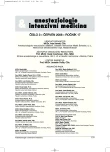-
Medical journals
- Career
Assessment of performance of NMT stimulators used during anaesthesia in the Czech Republic
Authors: M. Adamus 1; P. Adamus 2; R. Bělohlávek 3; M. Ludma 3; P. Hropko 3
Authors‘ workplace: Klinika anesteziologie a resuscitace, Fakultní nemocnice a Lékařská fakulta Univerzity Palackého, Olomouc 1; Rapid System, s. r. o., Olomouc 2; Katedra informatiky, Přírodovědecká fakulta Univerzity Palackého, Olomouc 3
Published in: Anest. intenziv. Med., 17, 2006, č. 3, s. 145-155
Category: Anaesthesiology - Original Paper
Overview
Objective:
To assess the performance of NMT stimulators used during anaesthesia in the Czech Republic. To test the ability of the stimulators to work as “constant-current generators”.Design:
Laboratory prospective controlled studySetting:
Department of Anaesthesiology and Intensive Care, University Hospital and Palacky University, Olomouc.Materials and Methods:
Six commercially available peripheral nerve stimulators were studied in laboratory settings. Each stimulator (single twitch mode, stimulating current 10, 20, 30, 40, 50 and 60 mA, respectively) was set to work at different loading resistance from 50 to 10000 Ohm. Based on the voltage measured on the load and Ohm’s law, the actual intensity of the current was determined. The loading characteristics were specified.The morphology of the stimulating pulse was recorded from the oscillographic screen. The stimulators were ranked from the best to the worst in each category.Results:
The TOF-Guard® (Biometer) and TOF-Watch® SX (Organon) were the most accurate stimulators in terms of the stimulating current. All stimulators except the Innervator NS252® (Fisher-Paykel) were less precise at higher currents (60 mA) than at lower stimulation intensities (10 mA). Multistim LA (Pajunk) showed the best impulse morphology; one of the stimulators (AS/3™, Datex-Ohmeda) offered both accelerometric and electromyograhic evaluation of muscle response.Conclusion:
The manufacturers declare all the tested stimulators to be “constatnt-current generators”. Based on the test results, some of the stimulators did not meet this attribute because their output was load-dependent (ParaGraph®, Vital Signs).Key words:
neuromuscular transmission – peripheral nerve stimulator – monitoring – stimulation pattern
Labels
Anaesthesiology, Resuscitation and Inten Intensive Care Medicine
Article was published inAnaesthesiology and Intensive Care Medicine

2006 Issue 3-
All articles in this issue
- A comparison of haemodynamic changes using thoracic epidural anesthesia versus standard balanced anaesthesia during on-pump coronary artery bypass grafting
- Assessment of performance of NMT stimulators used during anaesthesia in the Czech Republic
- Optimization of the intravascular volume in multiple trauma patients using esophageal Doppler – preliminary results
- Analysis of the specificity and sensitivity of procalcitonin in relation to other markers of inflammation in critically ill patients
- Assessment of regional tissue perfusion by indicator microdialysis technique
- Surfactant – use in adult patients
- Anaesthesiology and Intensive Care Medicine
- Journal archive
- Current issue
- Online only
- About the journal
Most read in this issue- Surfactant – use in adult patients
- A comparison of haemodynamic changes using thoracic epidural anesthesia versus standard balanced anaesthesia during on-pump coronary artery bypass grafting
- Assessment of regional tissue perfusion by indicator microdialysis technique
- Assessment of performance of NMT stimulators used during anaesthesia in the Czech Republic
Login#ADS_BOTTOM_SCRIPTS#Forgotten passwordEnter the email address that you registered with. We will send you instructions on how to set a new password.
- Career

